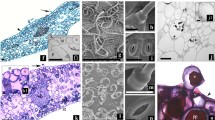Abstract
Leaves of micropropagated highbush blueberry (Vaccinium corymbosum) cv. ‘Bluetta’ have been observed during the acclimatization phase. In vitro-developed leaf cells were circular and small, the spongy parenchyma was discontinuous and disorganized and formed by 1–2 layers of cells with large intercellular spaces and the palisade to spongy mesophyll thickness ratio was 1:1.5. After rooting ex vitro, the first leaves formed under natural conditions showed substantial changes in the anatomical characteristics. After 6 months, the plants produced leaves similar to those in field-grown plants. The palisade cells were rectangular, the spongy parenchyma was formed by 3–4 layers of cells and the intercellulars were around the stomata. Leaves from field-grown plants lost 24 % of water during 150 min after excision while leaves from in vitro shoots lost about 50 % of water in the same time. Leaves from in vitro shoots showed a higher number of smaller stomata (361 per mm2), with the guard cells forming a circular ring; the stomata frequency in field-grown leaves was 241 per mm2 and the guard-cells were elliptical.
Similar content being viewed by others
References
Brainerd, K.E., Fuchigami, L.H.: Acclimatization of aseptically cultured apple plants to low relative humidity. - J. amer. Soc. hort. Sci.106: 515–518, 1981.
Eccher, T., Noe, N., Piagnani, C, Castelli, S.: Effects of increasing concentrations of BAP and 2iP onin vitro culture ofVaccinium corymbosum. - Acta Hort.179: 879–881, 1986.
Gribaudo, I., Novello, V., Restagno, M.: Epicuticular waxes in micropropagated grapevine. - In: VIIIth International Congress of Plant Tissue and Cell Culture. S2–49. Firenze 1994.
Noe, N., Eccher, T.: Influence of irradiance onin vitro growth and proliferation ofVaccinium corymbosum (highbush blueberry) and subsequent rootingin vivo. - Physiol. Plant.91: 273–275, 1994.
Preece, J.E., Sutter, E.G.: Acclimatization of micropropagated plants to greenhouse and field. - In: Debergh, P.C., Zimmerman, R.H. (ed.): Micropropagation: Technology and Application. Pp. 71–93. Kluwer Academic Publishers, Dordrecht - Boston - London 1991.
Romano, A., Martins-Loncao, M.A.: Water loss duringex vitro acclimatization of micropropagated cork-oak (Quercus suber L.) plantlets. - In: VIIIth International Congress of Plant Tissue and Cell Culture. S2–19. Firenze 1994.
Wetzstein, H.Y., Sommer, H.E.: Scanning electron microscopy ofin vitro-culturedLiquidambar styraciflua plantlets during acclimatization. - J. amer. Soc. hort. Sci.108: 475–480, 1983.
Author information
Authors and Affiliations
Rights and permissions
About this article
Cite this article
Noé, N., Bonini, L. Leaf anatomy of highbush blueberry grownin vitro and during acclimatization toex vitro conditions. Biol Plant 38, 19–25 (1996). https://doi.org/10.1007/BF02879626
Received:
Accepted:
Issue Date:
DOI: https://doi.org/10.1007/BF02879626




